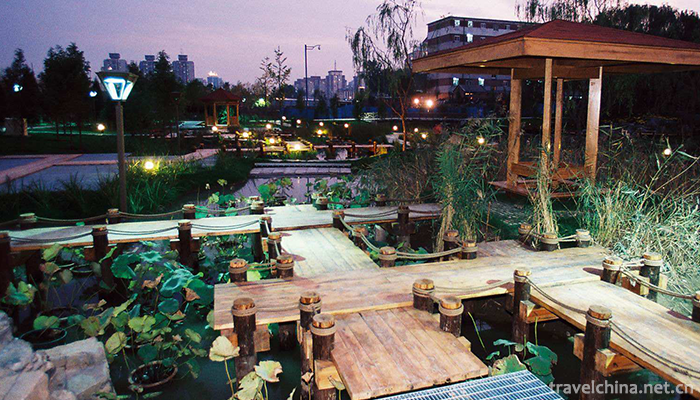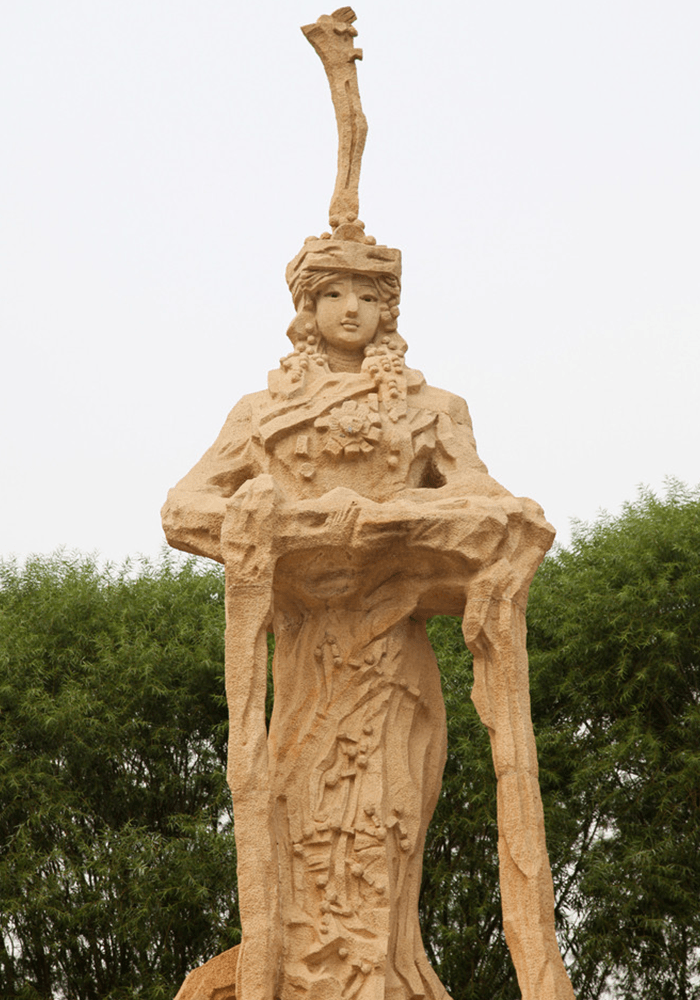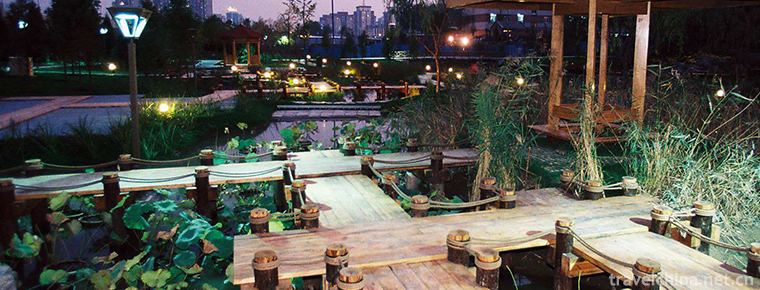Yuan Dynasty Capital City Wall Site Park Yuandadou Chengyuan Site Park
The Yuandu Chengyuan Site Park was built on the Tucheng Site of Yuandu (National Key Cultural Relics Protection Unit, batch No. VI-1). It is located near Mingguang Village, Southern College Road, Haidian District, in the west, and turns northward to Huangting Pavilion and eastward to Madian and Qijia Huozi. National 4A-level scenic spot is a modern urban heritage park with cultural and historical connotations, which integrates the protection of historical relics, the leisure and recreation of citizens, the improvement of ecological environment and disaster prevention and emergency shelter.
As a testimony and material relic of the development of Beijing's urban civilization, the Yuandu Site is an important fact in the study of the changes of Beijing's urban sites, and is of great significance to the exploration and development of Beijing's cultural history. And it is the first humanistic Olympic landscape built in Beijing.
Historical development
From the ancestors of the Yuan Dynasty to the third year of the Yuan Dynasty (1266), Kublai Khan decided to rebuild the new city in the northeast of the former central capital, and began construction in 1267. Take Qionghua Island (now Beihai) as the center to build Palace city, imperial city, altar temple and so on. By the ninth year of the Yuan Dynasty (1272), it was named Dadu. In the twenty-first year (1284), it was completed, with a perimeter of 28.6 km . In the first year of Hongwu Ming Dynasty (1368), after the conquest of Yuandu, the northern city wall shrank about five miles to the south, which is the ruins of the city wall as high as more than ten meters, commonly known as Tucheng.
In 1957, Tucheng was listed as a key cultural relic protection unit by the Beijing Municipal People's Government.
In order to protect the Yuandouyuan ruins, the Tucheng Greening Team was set up in Chaoyang District on September 25, 1974. On March 10, 1988, the Beijing Municipal People's Government formally approved the construction of the park and named it "Yuandouyuan Ruins Park" .
In September 1989, the district government erected a monument on the north side of the west end of Jian'an East Road. The monument is 2.5 meters high, 4 meters wide and 1 meter thick. There are more than 600 words of "Dadu Fu" inscribed on the east side of the tablet, and the inscription of "Yuan Dachengyuan Site" inscribed on the west side of the tablet. The inscription briefly introduces the vicissitudes and vicissitudes of the city wall of the Yuan Dynasty for more than 700 years .
In order to protect the ruins of Yuandou Placanticline and cooperate with the construction of Olympic landscape, Chaoyang District Greening Bureau carried out the overall transformation of the ruins park of Yuandou Placanticline in 2003. The renovated Yuandu City Placanticline Site Park has created four of the largest in Beijing and one of the first in China: the largest urban belt park, the largest outdoor sculpture, the largest constructed wetland and the first pilot park to complete the construction of emergency shelters in Beijing. Therefore, Beijing has become the first city in China to carry out emergency shelter construction and hang the "emergency shelter" sign. It has created a classical garden for Beijing, which is "people-oriented, green as the body, water as the line, history as the soul, and disaster relief".
On May 25, 2006, "Yuandu City Wall Site" was announced as the Sixth Batch of national key cultural relics protection units.
Main attractions
The ruins park of Yuandudouyuan is a narrow strip with a total length of 9 kilometers, spanning Chaoyang and Haidian districts. The five nodes in the park, Jimen Yanshu, Dadu Jiandian, Ancient Yuan Xinyun, Dadu Grand Festival and Longze Yueyue, connect Chaoyang and Haidian sections. From West to east, it shows the development of the city of Beijing for more than 700 years from the Yuan Dynasty to the present.
Haidian section
After the completion of Yuandoucheng Site Park within the boundaries of Haidian District, Yuandoucheng Site Park has ten scenic spots, namely: Chengyuan nostalgia, Jimen tobacco tree, Tieqixifeng, Thistle Fenfeifei, Yinbodeyue, Lagerstroemia, Dadu Canon, Shiguan Xinyi, Anqisheng Age, Yanyun Pastoral .
The "Jimen Tobacco Tree" node is the starting point of the west end of Yuandu Park. The scenic spot is especially beautiful in spring, and spring is also the starting point of a year. The "Jimen Smoke Tree" symbolizes the early stage of the development of the ancient city of Beijing, and implies the bright future of the city with the vigor of spring. According to legend, Tucheng is an ancient Jizhou site, the old buildings and halls are both abandoned, but there are many trees near Tufu in the gate, which is the "Jimen tobacco tree" in the eight sceneries of Yanjing. Existing Qianlong imperial plaque, describing the "Jimen tobacco tree" poems and verses were carved into murals, to increase the humanistic connotation.
Chaoyang section
Yuandudou Chengyuan Site Park (Chaoyang Section) is located on the East and west sides of Beijing Central Axis Road and the south side of Olympic Park. It is the largest belt park in Beijing urban area. It is 4.8 kilometers long and 130 to 160 meters wide, covering 67 hectares. It includes three first-class scenic spots: Yuancheng New Image, Dadu Shengsheng and Longze Yueyue. Six second-class scenic spots include: Shuangdu Tour, Sihai guests and friends, Begonia Huaxi, Anding Shenghui, Shuijie Huadeng and Guyun of Corner Tower .
"Double Capital Patrol" Scenic Spot: The relief wall reflects the scenes of the Yuan Emperor's spring and autumn return and reception by hundreds of officials. While understanding the prosperity of the Yuan Empire, the tourists also know the characteristics of the combination of grassland culture and Central Plains culture, as well as the characteristics of political domination with equal emphasis on both the majority and Shangdu .
"Four Seas Guests and Friends" Scenic Spot: Located on the south side of the Chinese National Park, this scenic spot reflects the political characteristics of Yuan Dynasty, a country open to the outside world, corporals of courtesy and virtue, and countries all over the world come to worship, greet or engage in exchanges. The sculptures of "Qinghua Porcelain", "Arrow and Shield" and "Copper Wall and Iron Wall" on the three sinking horseface squares on the north side of the scenic spot reflect the achievements of the Yuan Dynasty in art and military affairs. "Begonia Huaxi" Scenic Spot: Located on the east side of Panda Ring Island, it is preserved after finishing, repairing and improving. Many kinds of Begonia trees, such as Xifu Begonia, Tiebei Begonia, Venus Begonia, Begonia pendulata and so on, are planted in the scenic spot, which is the largest Begong forest in Beijing urban area.
"Most prosperous" scenic spot: located in the east of Xiaoguan intersection of Anding Road. The "most prosperous" group sculptures and large murals with a total length of 80 meters, together with horses, stone sheep, wooden pavilions and other garden sketches, reproduce the characteristics and outstanding achievements of the Yuan Dynasty in politics, economy, military, science and technology, culture and life, and show the characteristics of rough and heroic grassland culture. They are the largest outdoor group sculptures in Beijing.
"Longze Yuyue" Scenic Spot: At the eastern end of the park, the urban light rail and Xiaoyuehe obliquely intersect to form a triangle land, which resembles a dragon head and covers an area of about 17,000 square meters, forming a natural wilderness wetland park with countryside scenery, and becoming the largest constructed wetland in the urban area of Beijing .
Environment construction
The coverage rate of Yuandu Chengyuan ruins park is 73%, Xiaoyuehe crosses, Henan side is Tucheng ruins protection area, and the north bank is greening scenic spot construction area. Xiaoyuehe River is the main water scenic area, seven aquatic plant areas planted lotus, reed, calamus, scallion and other aquatic plants, built a hydrophilic viewing platform. Along the Xiaoyue River, five wooden cruise ship wharfs and six river-crossing bridges with different shapes have been built to connect the beautiful scenery of different styles on both sides of the river. On shallow water surface, aquatic plants such as iris and scallion are planted .
In Yuandudou Chengyuan Site Park, there are crabapples and flower streams. Xifu crabapple, Tiebei crabapple, Venus crabapple and Begonia verticillata are planted. The Begonia Flower Festival in the park is one of the three major flower festivals in spring in Beijing, which are the Peach Blossom Festival in Xiangshan Botanical Garden and the Cherry Blossom Festival in Yuyuantan Lake. It has been held since 1998. During the event, visitors can listen to soothing background music while enjoying crabapple flowers in the park free of charge. Up to the 15th Begonia Flower Festival in 2012, more than 25,000 varieties of Begonia have been planted in Yuandudou Chengyuan Site Park, which is the largest variety and quantity of Begonia in Beijing.
Traffic routes
By public transport:
1) No. 407 bus, Anzhen Xili, will get off immediately.
2) 653, 409, 380, 849, Te 2, 515 Anzhen Hospital North Station will be there immediately.
3) Beitucheng Station of Metro Line 10 will arrive immediately after getting off the train.
Self-driving route:
1) The North Third Ring Anhua Bridge turns right (eastward) from north to Tucheng East Road and is about 100 meters south.
2) The North Fourth Ring Anhui Bridge turns right (west) from south to Tucheng East Road, about 500 meters south.
The "metropolitan canon" echoes the "metropolitan festival" remotely, reproducing the construction scene and the prosperous scene of the Yuan metropolis .



-
2.Letinous edodes chicken Noodles
Letinous edodes stewed chicken originated in Northern Jiangsu
Time 2018-10-12 -
3.Jingpo Lake
Jingbo Lake: National AAAAA-level tourist attractions, World Geopark, National Key Scenic Spots, International Ecotourism Resort, National Civilized Scenic Spots Demonstration Sites
Time 2018-12-05 -
4.Oriental Ruihai International Hot Spring Resort
Oriental Ruihai International Hot Spring Resort is a hot spring real estate project jointly invested by Shandong Sanzhong Group and Shandong Xingsheng Mining Group, with a total investment of 300 mill
Time 2018-12-20 -
5.Yunwushan Scenic Area
Yunwushan Scenic Spot is located in Paulownia Shop in the northwest of Huangpi District. It enjoys the reputation of "Xiling Resort Area, North Chu Famous Area, Beixi Border Barrier and Handizush
Time 2018-12-22 -
6.Green Island Tourist Villa
Green Island Tourist Villa is one of the eight new scenic spots in Chaozhou, the national demonstration sites of leisure agriculture and rural tourism, the base of science and technology
Time 2019-02-06 -
7.Tea ceremony
Tea art is a kind of culture. On the basis of Chinese excellent culture, tea art has absorbed and borrowed other art forms extensively, and expanded to literature, art and other fields
Time 2019-04-15 -
8.Two strands
Erguxian is an ancient traditional opera, which was formed in Song Dynasty and has a history of more than 500 years. The two-strand string is evolved from folk minor,
Time 2019-04-28 -
9.han opera
Guangdong Hanju Opera, formerly known as "Ran Tan", "Waijiang Opera" and "Xingmei Hanju Opera", is one of the Hakka Opera genres in Guangdong Province
Time 2019-05-01 -
10.Suona Art
Suona art is a manifestation of traditional Chinese folk culture. In 2006, Qinyang City of Henan Province and Qingyang City of Gansu Province applied for intangible cultural heritage. Its basic musica
Time 2019-06-17 -
11.Xianshi ancient town scenic spot in Zigong City
Xianshi ancient town scenic spot in Zigong City stands on the Bank of Fuxi River 11 kilometers southeast of Zigong City, the "Millennium salt capital", which is in contrast with Zigong, a famous historical and cultural city.
Time 2020-10-15 -
12.Luzhou local culture
Luzhou cuisine is a branch of three main local flavor schools in Modern Sichuan cuisine. In June 2018, Luzhou City released four local standards for "Luzhou cuisine", namely, Douban tuoyu, dry roasted carp, Luzhou pickled sea pepper and Luzhou pickled ginger, marking that Luzhou has its own standard for "Luzhou cuisine".
Time 2020-12-14